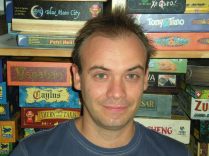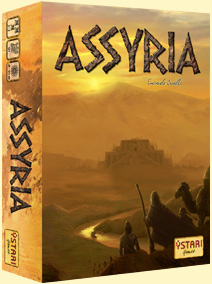Interview: Emanuele Ornella (Part 1)
Posted by James (admin) on January 4th, 2010
Today’s post is very special as it’s the first in what I hope to be an on-going set of occasional interviews with game designers. I’m always intrigued by the game design process so these interviews will focus on the game design process and the game of designing.
 Emanuele Ornella is an Italian game designer who has designed many games in recent years. His games include: Assyria (2009), Martinique(2009), Byzanz (2008), Hermagor (2006), Il Principe (2005), Oltre Mare (2004), and Fantasy Pub (2003).
Emanuele Ornella is an Italian game designer who has designed many games in recent years. His games include: Assyria (2009), Martinique(2009), Byzanz (2008), Hermagor (2006), Il Principe (2005), Oltre Mare (2004), and Fantasy Pub (2003).
Hi Emanuele. Thank you for talking to us about your design approach and experience. Seven game designs in seven years – that’s a very productive track record. Where did it start for you?
Ema: Well I always had a passion for games in general. I started to design my first videogame with Commodore 64 in the mid-80s. Then I started to play Heroquest and Magic the Gathering. At the end of 90s, I found boardgames again. I attended Lucca Game contest in early 2000s and I won the first place two years in a row. That make me to decide to try the way of Essen. A few months ago I moved again to videogames releasing two games (you can play here http://www.mindthemove.com/portal/mtm/playonline) that are revisited versions of two boardgames: Tokyo Train by Walter Obert, and Haunted House (a re-themed version of Bongo by Bruno Faidutti).
 You have said on your blog that you start a game design with the game mechanics and not the theme first. Where do you start on creating your new game mechanics? Are they inspired by other games or do they just come to you? Do you have a specific mechanic in mind when you start, i.e. I want to make a dice game, I want to make a card game?
You have said on your blog that you start a game design with the game mechanics and not the theme first. Where do you start on creating your new game mechanics? Are they inspired by other games or do they just come to you? Do you have a specific mechanic in mind when you start, i.e. I want to make a dice game, I want to make a card game?
Ema: I like to design games and I like to play games. I probably do not play as many games as other players do, because otherwise I will not have the time to design games; but, if I do not play game, I will not be inspired for my games. So there is a balance between the time I spend to play games and the time I spend to design games. Moreover, not all the games will inspire my design or will give me the passion to start to think to another one. But as soon as I start to think to a new idea that’s because I liked a mechanism on a game.
For example, Assyria was started just after a game of Evo. I always thought Evo is a great game blending several mechanisms together. The one I liked more is the multi-auction to get the bonus tiles. This was used again in Amun-Re (that is so one of my preferred games by far). Another mechanism is the way to score points at the end of the round for the terrain your dinos conquered. I discovered this year that Small World (or the old Vinci) designed by the same author (Philippe Keyhart) uses the same mechanism, and this one was the mechanic I was inspired for Assyria. In fact, in my game, you score points for each survived hut. But huts can give you camels (currency) if they lay on the rivers and Ziggurats also as a kind of super-hut that does not need to be fed (and therefore will survive forever). That was a similar concept but upgraded because, instead of one type of pawn (the dino), I had 2 types (huts and ziggurats) and, for one type, the score rule was modified to give victory points or currency.
Another nice mechanism I saw recently was in In the Year of the Dragon where you can buy the major privilege at the beginning which will give you constant points for the rest of the game. Ziggurat levels work in a similar way: if you add levels early, this will guarantee more income than if you develop later.
When I started to design Il Principe, I wanted to use roles like in Puerto Rico. However, my idea was for each role to have a major and a minor role. Even though Il Principe differs from Puerto Rico, I started from this idea.
So all in all I am starting a new game usually starting to think to a mechanism I liked in other games, but trying to modifying it so the result is. Did you ever guess I was inspired by Evo for Assyria?
 On your blog, you mention you like to add a theme as soon as possible. How do you decide on the theme? Do the game mechanics you are working on determine the theme, or do you have themes you like and try to fit the game mechanics into those themes?
On your blog, you mention you like to add a theme as soon as possible. How do you decide on the theme? Do the game mechanics you are working on determine the theme, or do you have themes you like and try to fit the game mechanics into those themes?
Ema: Il Principe for instance started with a sci-fi mechanism. The starting idea was to build a base on a moon or on another planet. I do not remember exactly why – I was probably reading a sci-fi novel at the time. Some themes may come from movies I watch (I watch very few movies) or books I read.
Martinique was inspired by a Lewis Carroll game called Lanrick. Lewis Carroll is mainly know for his novel Alice in Wonderland; however, he designed some board games and some logic and words games too. Lanrick is a two-player game (like Martinique) where each player moves his pawns (also like Martinique). I started to redesign the goal of the game and the pawn movement mechanic, but it was only when I decided on a pirate theme that I found the right way to score and the main goal for the game (which is to unbury hidden treasure). This theme was inspired by the novel by Tim Power called “On Stranger Tides”.
How much do games already available influence your decision? If someone has just released a game using the same theme of one your ideas, do you change your idea?
Ema: Well, I cannot play all the new games available, even if I would like to try. Each new game could be a source of inspiration so they’re worth a try; however, I’m not doing this very regularly. It happened that when I was working on Oltremare, the first version made by Mind the Move, Goa was released (in February). The main theme of Oltramare was the trade of the spices, but I decided to change the theme once I discovered Goa used the same one.
What game mechanics interest you? The games of yours that I have played do not have much luck-based play (which I like).
Ema: I like to vary the mechanics I use. Oltramare is a collecting game with some trading; Il Principe and Byzanz use auctions; Hermagor has an original multi-auction or multi-placement mechanism; Assyria is a resource and building management game; Fantasy Pub, the first one, is probably the most luck-driven because it uses dice.
How original do you try and make your ideas so they stand out?
Ema: I think there are few very original games. There have been some milestones which have made history in boardgames: Magic the gathering started a new kind of game; El Grande started the series of the majority games; Verrater/Citadels/Puerto Rico were the first games using roles; Caylus used worker placement; Pandemic is the most famous collaborative game. So, I do not think it’s easy to have a very original game. I am trying to approach it more the way I described: To use a mechanism I like whilst adding some difference. Can this be called original? Maybe, yes. For sure I don’t like to design a game too similar to another one. I don’t see any need to play Cuba, The pillars of earth or other similar games if I can play Caylus.
That’s the end of part one. Read the second and concluding part of the interview. Also, you can read a review of Assyria too.
James.


January 5th, 2010 at 12:51 am
The interviews are a great idea. I’m interested in reading more of them. Looking forward to part 2 tomorrow!
January 5th, 2010 at 2:38 am
Excellent. Thanks for the feeedback, Jacob. I’m hoping to have more interviews in the future.
James.